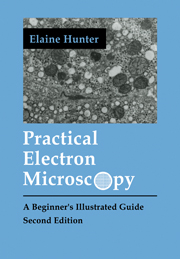Chapter 3 - Cutting
Published online by Cambridge University Press: 05 June 2012
Summary
SEMITHIN SECTIONS
Introduction
Cutting semithin sections prior to thin sections is useful for two reasons. It indicates whether or not fixation, dehydration, and infiltration have been carried out properly, and it helps to locate areas of interest (e.g., glomerulus, lesion, specific cell type). This avoids unnecessary thin sectioning of unsuitable blocks. Semithin sections of tissue processed for electron microscopy also provide excellent material for photomicrography (Fig. 3.1). Fixation is always superior to material fixed for conventional light microscopy and the sections (0.5–2 µm), provide better resolution than paraffin sections, which are usually about 5 µm
Semithin sections are cut with a glass knife, which is fitted with a trough to hold distilled water, and are usually stained with alkaline toluidine blue (Trump, Smuckler, & Benditt, 1961). A silver staining method that works well on resin embedded tissue (Rosenquist, Slavin, & Bernick, 1971) is also included here [Fig. 3.1 (bottom)].
It is important to be familiar with all of the ultramicrotome controls. If a manual is not available, request one from the manufacturer.
Chemicals and Equipment
Knife-Preparation Equipment
Knife maker (Fig. 3.2A).
Glass strips – 25 mm x 400 mm x 6.4 mm (1 in. x 1⅝. x ¼in.) (Fig. 3.2B).
Towels, lint-free.
Liquid detergent.
Paintbrush – 25 mm (1 in.).
Dissecting microscope.
Plastic tape – 10 x 33 m (⅜in. x 100 ft) (Fig. 3.3).
Razor blades, single-edged (Fig. 3.3).
Nail polish, clear (Fig. 3.3).
Blunt-end forceps – 125 mm (5 in.) (Fig. 3.3).
Perspex box to hold glass knives (Fig. 3.5).
- Type
- Chapter
- Information
- Practical Electron MicroscopyA Beginner's Illustrated Guide, pp. 31 - 70Publisher: Cambridge University PressPrint publication year: 1993



